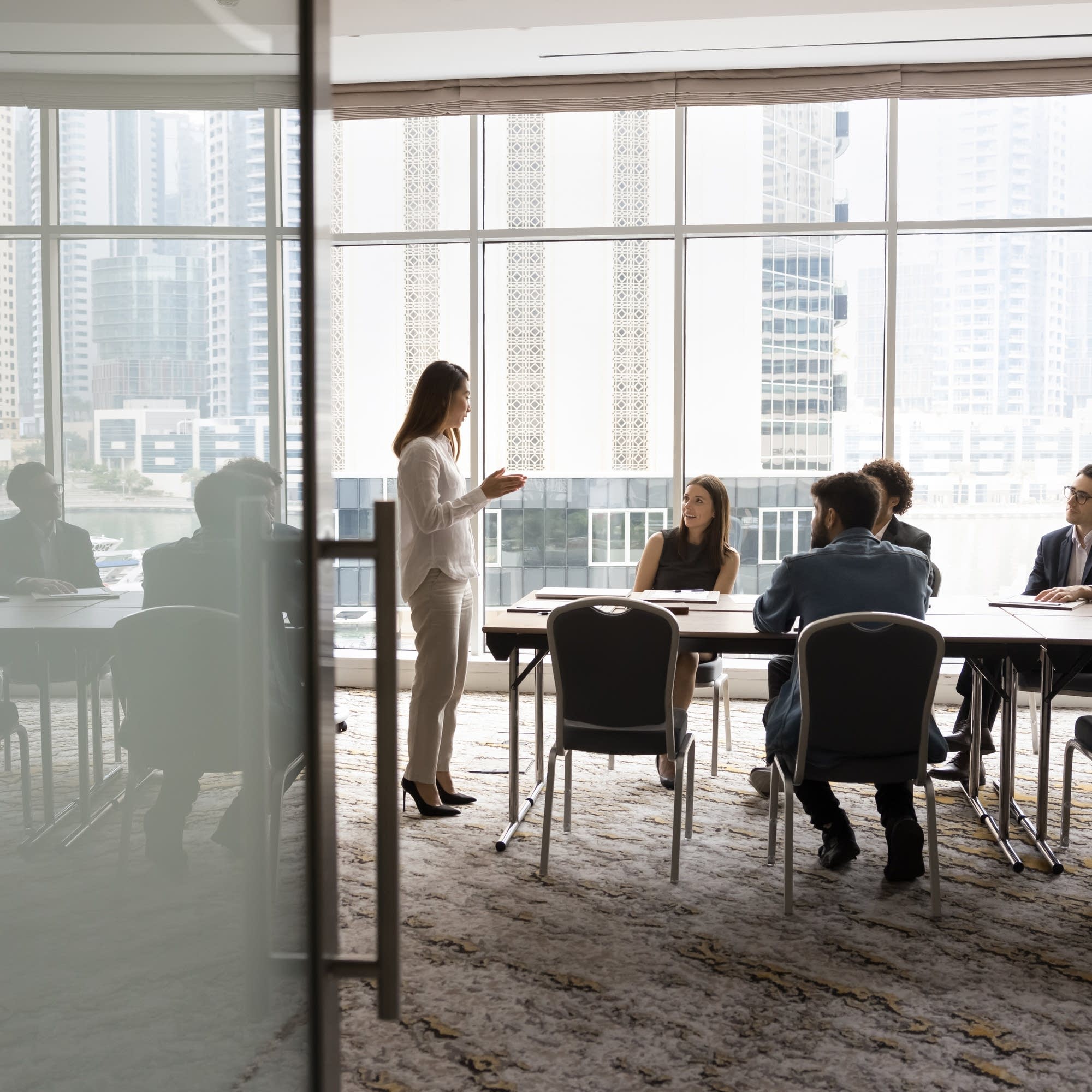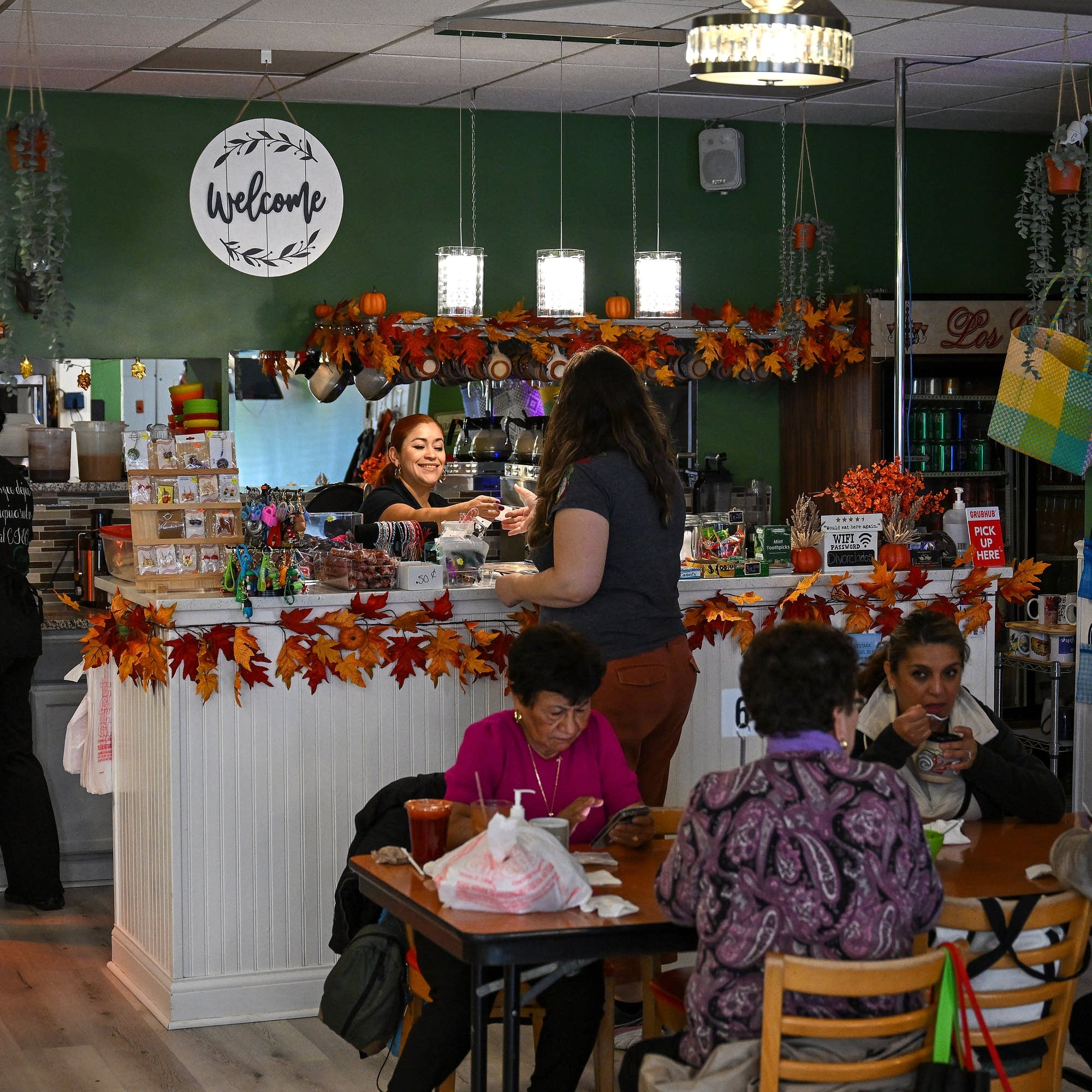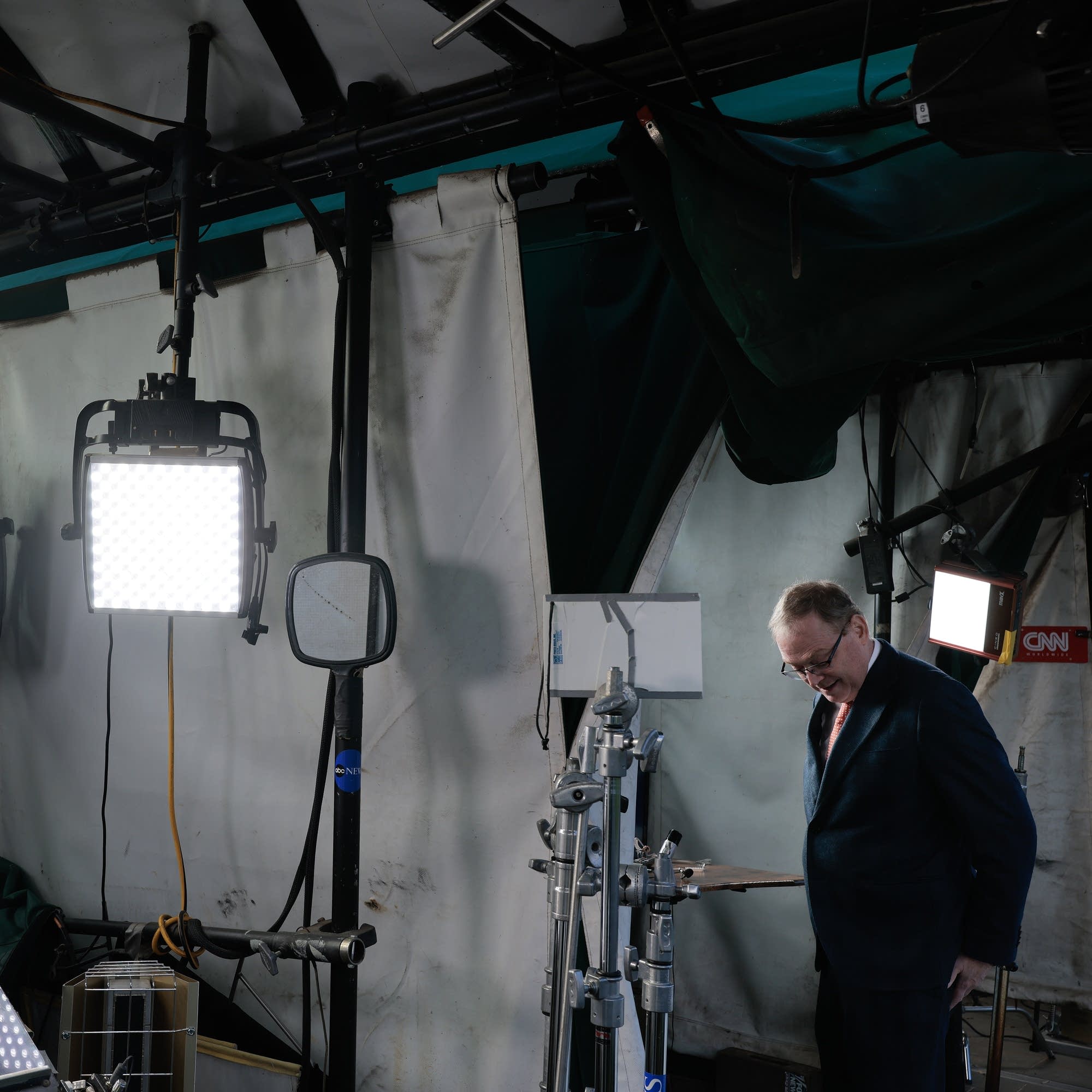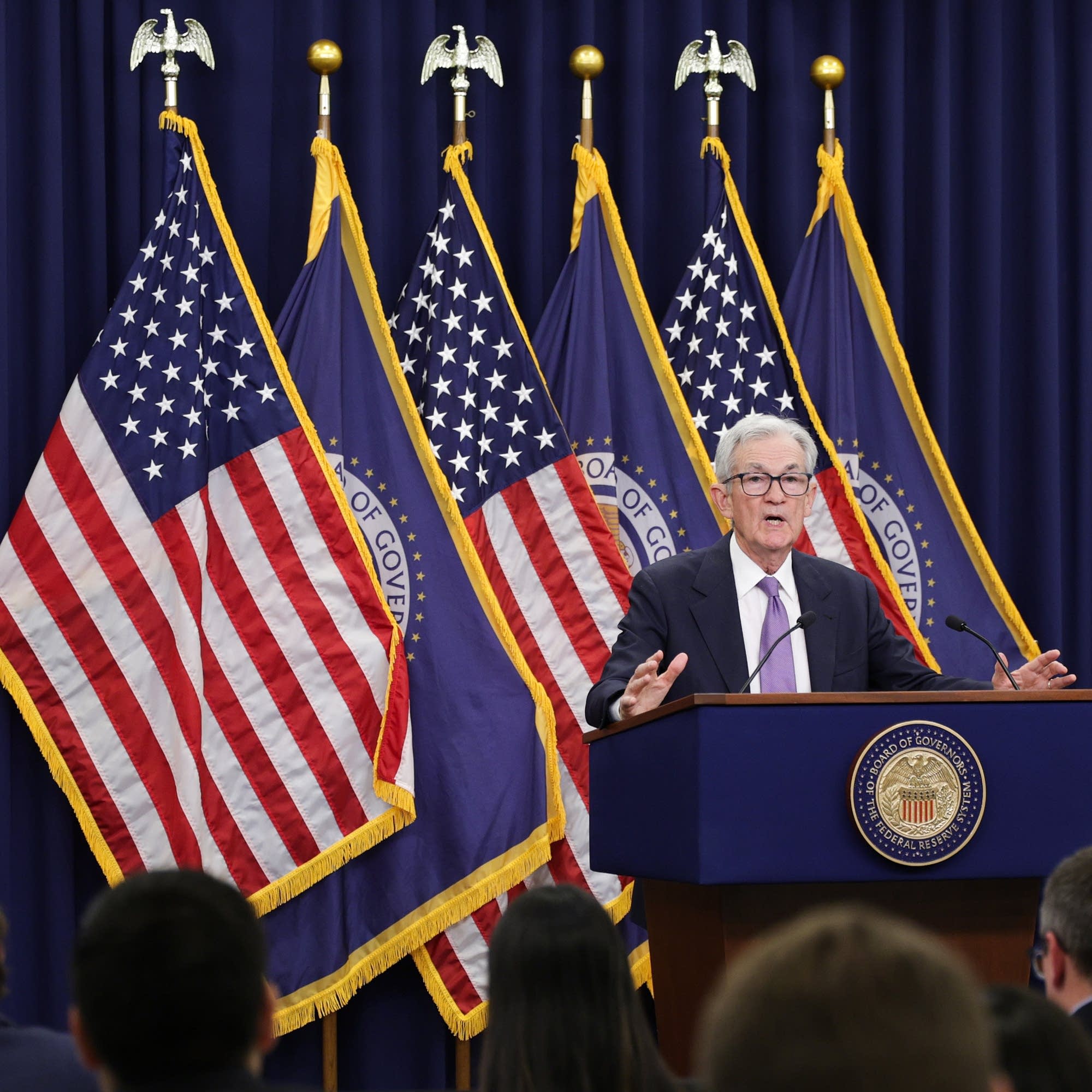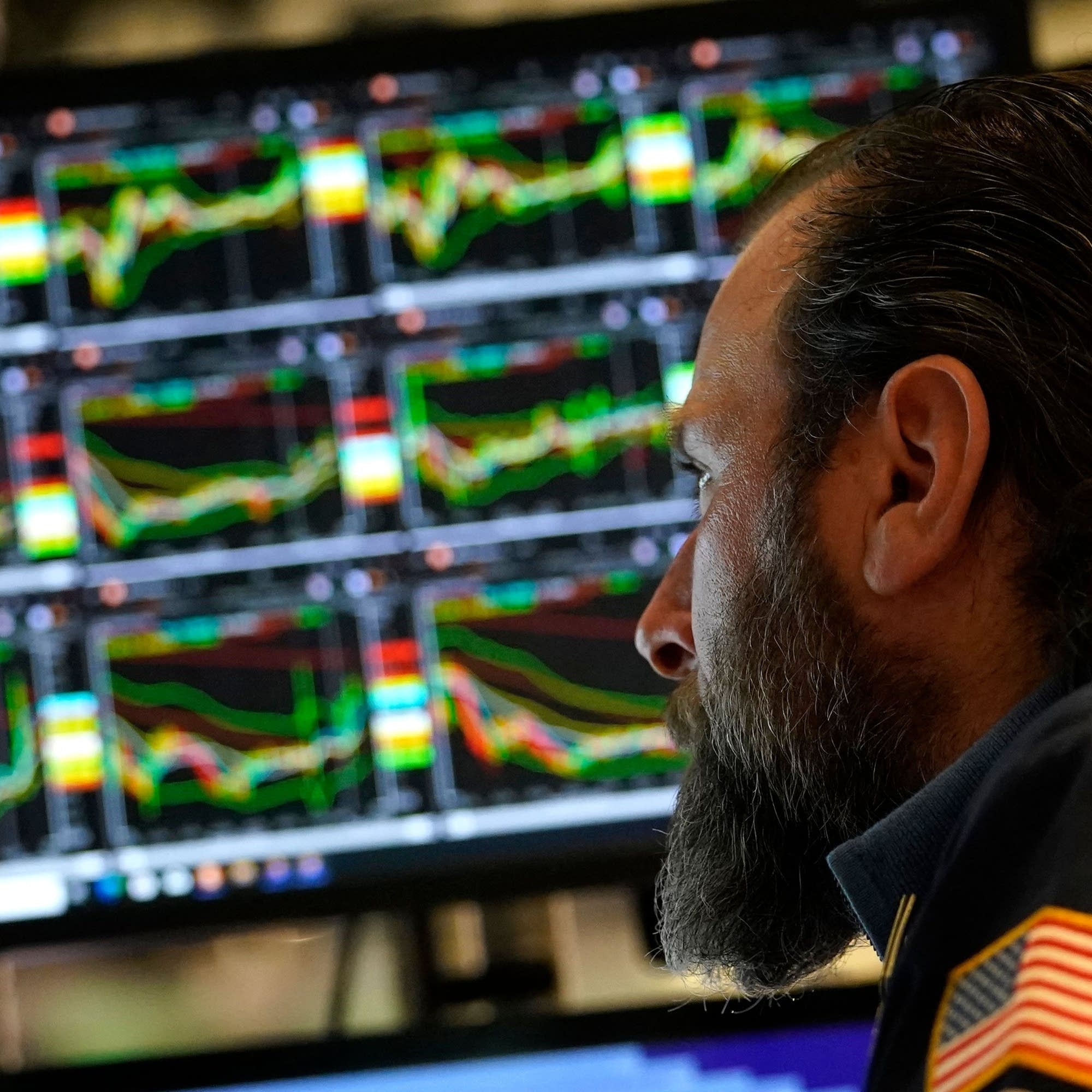CEO confidence sinks
CEO confidence fell in the latest quarter of 2025. Executives surveyed by The Conference Board voiced concerns over inflation, tariffs, and global trade uncertainty. In this episode, how the economic mood of corporate leaders could affect everyday Americans. Plus: Chipmaker TSMC reported a profit surge amid increased demand, a career tech program in Alabama trains the next generation of skilled workers, and the NFL remains a cultural and economic powerhouse despite ongoing challenges.
Every story has an economic angle. Want some in your inbox? Subscribe to our daily or weekly newsletter.
Marketplace is more than a radio show. Check out our original reporting and financial literacy content at marketplace.org — and consider making an investment in our future.
Press play and read along
Transcript
Introducing your new Dell PC with the Intel Core Ultra Processor. It helps you handle a lot even when your holiday to-do list gets to be a lot.
Like organizing your holiday shopping and searching for great holiday deals and customer questions and customers requesting custom things, plus planning the perfect holiday dinner for vegans, vegetarians, pescatarians, and Uncle Mike's carnivore diet.
Luckily, you can get a PC with all-day battery life to help you get it all done. That's the power of a Dell PC with Intel inside, backed by Dell's Price Match Guarantee.
Get yours today at dell.com/slash holiday. Terms and conditions apply.
See Dell.com for details.
Sign up at odoo.com. That's odoo.com.
We'll do some non-government data. We'll sample some manufactured meat and we'll play a little football.
From American public media, this is Marketplace.
In Los Angeles, I'm Kyle Risdahl. It is Thursday today, 16 October.
Good as always to have you along, everybody.
Here with a list of the government economic reports not delivered today.
Retail sales, the producer price index, both core and headline, first-time claims for jobless benefits, and manufacturing and trade inventories and sales, which is the Census Bureau's fancy way of saying business inventories, how much stuff they've got on the shelves to sell to us.
None of those came on this Thursday, and yet, how this economy is doing and where it might be going is of obvious interest to all of us.
So we turn instead to the people running America's companies and the conference board's measure of CEO confidence. Less confident, more cautious is how they're feeling.
The measure fell in the fourth quarter. More executives feeling negative about the economy than are feeling positive.
Marketplace's Kristen Schwab starts us off.
CEO confidence doesn't necessarily reflect the economy or the lives of regular people living in it, but CEOs do have insight and influence.
Jeffrey Sonnenfeld, a professor of leadership at Yale, says that makes measuring their feelings important.
While it's perceptual, it's perceptual by the actual decision makers, and it's in the here and now. It's immediate.
CEO perception right now is that the economy is on pause.
Dragging inflation, aka stagflation, is a top concern. So is an economic slowdown, though notably the more extreme word recession came up very very little in the conference board survey.
Tariff talks have ramped up again, and President Trump has been commenting on the performance of specific CEOs.
There's so much uncertainty there about whether or not you're going to get shaken down to surrender a piece of your business, or your costs of doing business with another country are going to skyrocket.
On a positive note, it seems like leaders are kind of getting used to the chaos. Stephanie Guichard, a senior economist at the conference board, says companies intend to start spending again.
The way they plan to do it, though, may not be such a boon to the American workforce. They are facing high cost pressure, but as a result, they want to invest more in AI and other new technologies.
Tariffs have increased the necessity to save money with AI.
Now, the conference board survey doesn't represent overall CEO sentiment. All 130 people surveyed lead big Fortune 500 companies.
Olusanola is an economist at Fitch Ratings.
Large corporations, those CEOs, have a much better sentiment and they're much more optimistic compared to the CEO of smaller firms.
It means the overall economic outlook among businesses is probably much more of a mixed bag. A resilient but fragile economy.
And that's somewhat oxymoronic, but that's where we are.
One economic force could propel us forward. Another could knock us down.
In New York, I'm Kristen Schwab for Marketplace. On Wall Street today,
nope. We'll have the details when we do the numbers.
There are, give or take, a dozen companies on this planet that the markets say are worth more than a trillion dollars.
There are, of course, the usual suspects, the ginormous AI-centric tech companies, NVIDIA, Microsoft, Apple, Alphabet, Amazon, and Meta.
The 10-digit club, though, also includes TSMC, Taiwan Semiconductor Manufacturing Company, on which those ginormous AI-centric tech companies depend to actually make the advanced computing chips that they need.
And that is a pretty great business to be in right now. TSMC this morning reported a whopping 39% increase in quarterly profits over a year ago.
That's on $33 billion in revenue, $33 billion
in just three months. Marketplace is Daniel Ackerman.
Took a look at the world's chip maker of choice. The factories where TSMC makes its chips are a sight to behold.
I mean, they are just massive.
The scale and sophistication is almost beyond human imagination. Mike Schmidt researches industrial policy at Princeton.
He's been to those factories, or fabs, and he says a single one can be the size of 11 football fields and at a given site you know they might have six or eight fabs operating side by side totally interconnected with each other through internal subways that carry wafers from one fab to the other and the chips that come out you have very likely used them today says ishwar prasad a professor of trade policy at cornell the SMC is embedded in your life in many ways the chips are used in smartphones TVs cars computers and if you're the AI type, your last chat GPT query was run on chips made by TSMC.
It has pretty much cornered the market for these high-performance, high-tech chips.
TSMC makes the bulk of those chips in Taiwan, where the firm is headquartered, but it's expanding production in the U.S., including in Arizona. And that is likely to increase over time.
Driven in part by incentives offered by the U.S. government, which wants to make sure it can get the chips it needs in case something happens to Taiwan.
That's according to Gil Luria, a tech analyst at DA Davidson. If China does pursue military action against Taiwan, there could be a disruption to the whole global supply chain.
But Luria says moving production of these very complicated chips to the U.S. will only happen bit by bit.
This is a relatively small part of their capacity, and it's capacity that takes a very long time to ramp up.
So for the foreseeable future, Luria says Taiwan will remain the global center of chip making. I'm Daniel Ackerman for Marketplace.
About a third of global greenhouse gas emissions over the past 35-ish years have come from our food.
That's data from a UN study, growing it, packaging it, transporting it, and ultimately wasting a lot of it. Climate change is making it harder to produce a lot of our food, too.
So, to feed a growing population on a hotter planet, we're going to have to make some changes. Enter now our new season of our climate podcast, How We Survive.
Marketplace's Amy Scott has been on a food tour of the future: Ways that we can keep eating what we love in a changing world.
Most startups have some kind of romanticized origin story, but Justin Colbecks might take the cake for me.
About 10 years ago, he was visiting his friend Aria Elfenbein, who had trained as a cardiologist. We went and visited his lab, and he was culturing cardiomyocytes, so heart muscle cells for humans.
Culturing, as in growing them in a dish.
And these incredible cells in the dish will beat. Like they have this pacemaking ability down to the cell.
You know, and Aria is like, see, I made meat.
I mean, obviously not the kind of meat that we would eat. That got them talking about what else they could grow in a lab.
And that eventually led to Wildtype, the company they founded in 2016 to make cultivated salmon. That is, salmon grown from cells.
Recently, I met Justin and Arya at Wildtype's headquarters. They call it the fishery.
It's in a converted brewery in San Francisco.
Justin says, if we want to keep eating seafood and meat in general, we're going to need more sustainable alternatives.
Everybody wants to eat more like Americans, meaning like a lot more meat and seafood and things that have a bigger climate impact.
So perhaps what we could do is just give them the same food that they like to eat, but completely reinvent how we do it.
To see how they're reinventing salmon, we do a few things,
starting with shoe covers.
We step into a sanitation room where we thoroughly wash our hands, suit up with shoe covers, safety glasses, a hairnet.
Oh, lab coat too, okay.
Aria says the process begins with salmon cells kept in a cryo freezer, just sort of slumbering. Yeah, everything that we create today came from one little fish
seven years ago. Since that time, we haven't had the need to go back to the animal.
We walk into a room that looks like a lab. When they want to grow more salmon, the cells come out of the freezer.
We take a few of those, we put them into these
shaking glass vessels. The vessels are filled with dark pink liquid that's swishing around.
What do you call this machine that's gently shaking these containers? It's a shaker.
It's kind of mesmerizing.
There's something meditative about it too. To grow the cells, they have to feed them a mixture including amino acids, sugars, and proteins.
What they're not ingesting are PCBs, microplastics, and other pollutants that end up in our fish. Once the salmon cells have grown enough, they get moved to bigger bioreactor tanks.
As you can see, though, cells in an environment like this don't know how to just get together and become sashimi. And so the next step from here is kind of providing the structure.
They cart the matured cells into a kitchen where the salmon cells are combined with a plant-based mixture, plus some paprika for coloring and natural flavoring.
And then we kind of pour it into the molds that you see in the oven right there to help kind of give it that shape.
The heat of the oven pasteurizes the concoction, and when it comes out of the mold, it's ready to be sliced into sashimi.
or smoked and prepared into something you might find at your local bagel shop, which is what I'm about to taste. So, I'm gonna make a little
everything cracker with just a touch of cream cheese,
wild-type salmon, one little pickled onion, and a bit of dill. Just very simple.
At a sushi bar they've built so visitors can taste the product, Justin is preparing a sample for me of their smoked salmon. All right, here we go.
Try to put the whole thing in my mouth? Okay,
It's good.
Tastes like salmon. It's the greatest compliment we could receive.
As a climate solution, cultivated meat isn't there yet. Investment has been relatively small compared to other climate tech, about $3 billion in the last decade.
Growing cells in bioreactors takes a lot of energy, and it's expensive to scale up. So far, just a few high-end restaurants are serving wild-type salmon in Seattle, Aspen, Portland, and San Francisco.
And not everybody is ready for lab-grown meat and seafood. Florida and Texas have recently passed laws banning it.
But in May of this year, Wildtype passed a milestone, becoming the first cultivated seafood company in the United States to earn FDA approval. In San Francisco, I'm Amy Scott for Marketplace.
How We Survive Season 8. Follow them on the platform of your choice.
Bring your appetite, as the saying goes.
Coming up, years ago, it was, that's where the bad kids go. Not anymore, though.
It's a labor market story, gang. But first, let's do the numbers.
Dow Industrials down 301 today, two-thirds of 1%, 45,952. The NASDAQ down 107 points, about 1%,
22,562 there. The SP 500 off 41 points, 6 tenths percent, 66, and 29.
TSMC had huge profits. TSMC still managed to lose 1.6 tenths percent today.
More banks reported higher third quarter earnings.
Didn't keep their shares from falling, though. Bank of New York Mellon Edge down 2%.
M ⁇ T Bank sank 3.5%.
Key Corp dropped 5.3%.
If you're thinking, hmm, what do they all have in common? The answer is smaller regional banks. Look out for that one.
It's a news story. Bonds up.
Yield on the tenure. T-note down 3.9 or 7%.
You're listening to Marketplace.
This Marketplace podcast is supported by the University of Illinois Geese College of Business. Earn a world-class MBA degree completely online at your own pace.
Through their online MBA program, you'll learn from amazing faculty and network with classmates on a global scale without having to put your career on hold.
Take your career to the next level by applying what you learn in real time. Get started at onlinemba.illinois.edu.
That's onlinemba.illinois.edu.
Recruitment. In law, it can feel clinical, procedural, lacking the human element that defines the profession.
LHH believes it should be more.
By connecting legal talent to meaningful opportunities, not just matching skills to job descriptions. Beautiful things happen in legal careers.
A mentor shapes a future. A team argues, then aligns.
The associates you hire become the advocates you trust. Making the thousands of hours in practice truly matter.
Recruitment, development, career transition.
LHH, a beautiful working world for the legal world.
Discover recruitment solutions today at LHH.com/slash beautiful.
Get the celebration ready with Justin Wine. Since 1981, Justin has been producing world-class Bordeaux-style wines from Paso Robles on California's Central Coast.
Justin offers curated gift sets, library wines, magnums, and even custom-etched bottles. Visit justinwine.com and enter Market 20 for 20% off your order.
Justin offers the perfect holiday gifts for clients, colleagues, friends, or family. Be sure to check them out at justinwine.com to receive 20% off your order for a limited time.
Fifth Third Bank's commercial payments are fast and efficient. But they're not just fast and efficient, they're also powered by the latest in payments technology built to evolve with your business.
Fit Third Bank has the big bank muscle to handle payments for businesses of any size, but they also have the FinTech Hustle that got them named one of America's most innovative companies by Fortune magazine.
That's what being a Fifth Third Better is all about. It's not about being just one thing, but many things for our customers.
Big Bank Muscle, FinTech Hustle.
That's your commercial payments, a fifth third better.
This is Marketplace. I'm Kai Brisdahl.
If you're a football fan, it's the Pittsburgh Steelers in Cincinnati tonight taking on the Bengals Thursday night football on Amazon Prime.
Basically, though, every day is game day in the modern NFL. That's the gist of Ken Belson's new book.
It's called Every Day is Sunday, How Jerry Jones, Robert Kraft, and Roger Goodell Turned the NFL into a Cultural and Economic Juggernaut. Ken, welcome to the program.
Good to have you on.
Thanks for having me. Could we just start with
a fairly simple proposition, I suppose? For those Americans who aren't tuned into the NFL and aware of it and fans of football, why does the NFL matter to the wider American economy?
Well, the NFL has kind of an outsized influence. It's roughly $23 billion a year as a business.
Somewhere in the order of 75 of the most watched television shows are football games every year.
Their reach into our culture has broadened with the spread of gambling. So they are becoming a 365-day a year enterprise.
The The commissioner, Roger Goodell, he often, or I have a colleague has quoted in the book who said he's not worried about the NBA or Major League Baseball. He sees the NFL as Disney and the Vatican.
He sees the NFL as well. That's quite a reach, I'm just saying.
Yeah, well, it's a family-friendly media company, which also happens to be a cultural institution.
The thing about it, just to get down to sort of business model brass tacks, is that the NFL has has a supply chain problem right there's only x number of games and because it is such a physical game it's not going to be able to expand too much more of course you know they used to be 12 back when i was a kid now it's you know the season is 18 weeks how are they maximizing the product with this
sort of necessary restriction on on the number of times that these guys can play yeah it's an interesting dilemma they face i mean the season the regular season is pretty much crammed into the fourth quarter of the year.
At the same time, they do have a supply chain problem insofar as the way that people are coming up through the pipeline.
The concussion crisis, for instance, has turned a lot of parents away from putting their sons in tackle football at six years old or eight or 10, 12 years old.
So there are issues that they face, and that's one of the reasons they're looking overseas for new fans.
I want to talk for a second about that concussion crisis, CTE, and what that has meant for players, for the players' families.
It is an enormous, has been and still is an enormous challenge for the league. It's a public relations problem.
And you point out that they've kind of dealt with it, not unlike Big Tobacco has dealt with some of its problems. Yeah, the league made a lot of missteps early on.
They assumed Paul Tagubu was quoted as saying this was a packed journalism problem.
But, you know, he set up a committee to study the issue, and that committee back in the 90s was putting out junk research. That's the overlap with the tobacco industry.
But when Roger Goodell came in, he realized this was more than an image problem. This was an existential problem.
So I have in one of the chapters, I cite quite a few documents that were uncovered in depositions, where you can actually see how the NFL pivoted around 2010-11, trying to change the narrative.
Let's get safer helmets. Let's teach kids how to tackle safely.
Let's put some neurologists on the sidelines. Let's improve the concussion protocols.
And in large part, a lot of the media moved on.
Even though the game itself hasn't changed fundamentally, the marketing around it has, I guess I would say, improved.
Just to
sort of keep going on this point, and it's really important not to minimize this. There's a race problem with the NFL as well, right?
There's the whole Colin Kaepernick thing, and the rules literally were changed so that you can't kneel during the national anthem.
Black players have been compensated at lower rates for their CTE issues. I mean, it's not like this is
a benign issue that the NFL has.
Yeah, the NFL has struggled with this in various ways over the years, and this goes back many years.
You know, the basic fact is roughly 70% of the players in the NFL are players of color, and 70% of the fans are white. So when you had the kneeling issue,
it brought strong reactions, including from the president.
The NFL has tried to pivot around this in Trump 2.0. They invited the president to the Super Bowl this year.
But yes, it's been a constant problem. You referenced race norming.
There was a case brought during COVID by some former players, black players, who
discovered that their claims for dementia were denied, and they claimed that black players were discriminated against.
The NFL ultimately changed its rules and many of those players subsequently received cash awards.
You've been doing this, you've been covering the NFL now for 15 years, you said, before we turn on the microphone. My question is, are you still a fan of the game?
I mean, yes, you have to cover it and all this, but
do you like to watch the games?
That's an interesting question.
A lot of sports reporters will tell you they just root for a good game because they have to write about something interesting.
You know, it's a bit of a guilty pleasure.
I've unfortunately, or fortunately, depending on your point of view, I've sat with some of these players who are just incredibly diminished and their families are left taking care of them.
It's a violent game, let's face it. And they're doing it for our entertainment.
They get paid for it, of course, but there's something sort of sadly poetic about how some of these guys end up.
And that's hard to shake, to be honest with you. Yeah, I hear that guilty pleasure thing.
Ken Belson covers the business of sports for the New York Times. He's got a book out.
It's a good one.
It's called Every Day is Sunday: How Jerry Jones, Robert Kraft, and Roger Goodell Turned the NFL into a Cultural and Economic Juggernaut. Ken, thanks a lot for your time.
I appreciate it.
Thank you, Crank.
We are, and I don't think this will be a surprise to anybody, an aging economy. More specifically, we're an aging workforce.
We've got a whole series we're doing about that, what it's going to mean here and globally that prime working age demographics are changing.
It's called the Age of Work, our series, next segment coming out next spring.
But anyway, and in the meanwhile, those changes mean big changes for how the American labor force learns.
Because as older, technically skilled workers retire, we're going to have more demand for people with education and training beyond high school, but not necessarily a four-year college degree.
Demand for more than 5 million such workers in the next seven years. That's according to a report last month from Georgetown University.
They are working on filling that gap down in coastal Alabama, as Corey Young reports.
Sparks shower the concrete floor as 17 year old Megan Todd practices pipeline welding at Baldwin Preparatory Academy in Loxley, Alabama.
The high school senior wears a helmet, gloves, safety goggles, and steel-toed boots as she and a classmate lift a heavy pipe into position. There we go, let's go.
Todd wasn't always a fan of school, but now? So by the time I graduate, I'll need to take my English class and I'll be able to get my associate's degree in welding.
Todd and classmates learn in a sleek modern building that opened last year. It's designed to simulate today's industry with students learning in a real-world work environment.
Principal Adam Seeley says they're role models for a new kind of career tech. Years ago it was that's where the bad kids go and now it's where the motivated kids go.
Motivated because students graduate with both workforce certifications and dual enrollment credits from nearby Coastal Alabama Community College.
It is a resume builder that isn't offered at any of the other schools. Nationally, about 2.5 million high school students take some dual enrollment from colleges and universities.
But Baldwin Prep is different. Here, industry helps design curriculum, and industry-recognized credentials are embedded into dual enrollment classes.
Some students will go on to college, others directly into the workforce.
Either way, the curriculum is designed with South Alabama's booming job market in mind, says Josh Diplantis, Dean of Workforce and Economic Development for Coastal Alabama Community College.
We have a lot of apprenticeship programs to where if it requires a full degree, maybe that student already has 9, 12, 15, 18 credit hours in that thing.
So it actually frees them up to do less school and more learning on the job.
To prepare for those jobs, students choose from 12 career pathways in fields like healthcare, manufacturing, aviation, and cybersecurity.
A third of the school students are low-income, but college credits are free for everyone. Complements of the state of Alabama.
Area industry adds extra dollars to school programs through sponsorships.
DePlantis says the return on the investment is an employee who chooses to live here.
But also, how do they stay here and develop a career where they can enjoy a wage that supports a family and a quality of life that we want to see them achieve?
One company counting on those graduates is Novellis. The company manufactures aluminum sheet used to make cans and car parts.
It's building a $4.1 billion plant a short drive from the school.
Plant manager Tori Holt says the Career Tech School played a role in site selection. I think Baldwin Prett was like the cherry on top.
The company has invested heavily in the school and its dual enrollment curriculum.
And so we are thinking about tomorrow, and we know for us to be here for that amount of time, we have to make sure that we have a constant flow of talent.
And Holt predicts these students will enter the labor force with a five to seven year advantage over high school graduates without this dual enrollment experience.
Welding student Megan Todd is counting on that springboard.
With the pipe now in place and ready to be worked on, Todd is happy to be in the welding room. After I go into a workforce for maybe five or so years, I want to go over to be a welding instructor.
With both a high school diploma and associate's degree just months away, it's a plan already in motion. In Loxley, Alabama, I'm Corey Young for Marketplace.
This final note on the way out today, a tale of two commodities. I'll report.
I'll y'all decide what it means. Commodity number one, oil, the U.S.
benchmark West Texas Intermediate down another 1.2% today, $57.44 a barrel. That is near a six-month low.
Commodity number two, gold, $4,331 an ounce today, an all-time high.
One of them very sensitive to expectations of future economic activity, the other very sensitive to expectations of future economic uncertainty. Hmm.
Our daily production team includes Olivia Burdett, Andy Corbin, Nicholas Guillong, Maria Hollenhorst, Sarah Leeson, Sean McHenry, and Sophia Terenzio. I'm Kai Risdahl.
We will see you tomorrow, everybody.
This is APM.
How do we go from free-range chicken and grass-fed beef to lab-grown meat? It's just this very simple notion
that basically the animals that we eat are using an awful lot of the earth.
And it's one of those things that once you see it, you can't unsee it.
I'm Amy Scott, and this week on How We Survive, we traveled to San Francisco to meet someone who went from growing human heart cells to producing cell-cultivated salmon.
Could it be the future of meat? Listen to How We Survive on your favorite podcast app.
